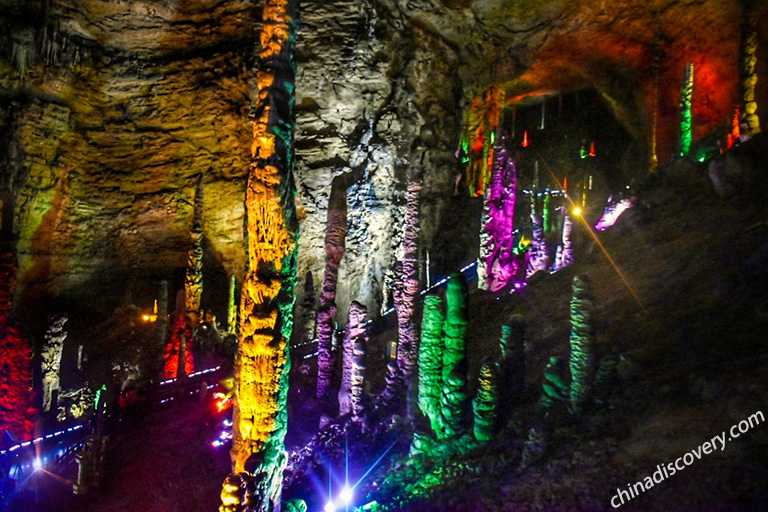
Where is the Yellow Dragon Cave?
The Yellow Dragon Cave (Chinese: 黄龙洞; pinyin: Huánglóng dòng; lit. 'yellow dragon cave') is a karst cave located in Wulingyuan District, Zhangjiajie City, Hunan Province, People's Republic of China. Renowned for its stunning stalactites, stalagmites, underground rivers, and lakes, it has been recognized as a national 4A rated scenic area and attracts over a million visitors annually.
Location and Access
The Yellow Dragon Cave is nestled in the heart of the Wulingyuan Scenic and Historic Interest Area, a UNESCO World Heritage Site. It's approximately 20 kilometers (12 miles) southeast of Zhangjiajie City and easily accessible by various means of transportation:
- By Bus: Frequent buses run from Zhangjiajie City's central bus station to the Yellow Dragon Cave scenic area. The journey takes roughly 30-45 minutes.
- By Taxi: Taxis are readily available in Zhangjiajie City and offer a more convenient, albeit slightly more expensive, option. The fare to the cave should be around 60-80 yuan.
- By Tour Group: Joining an organized tour group can be a hassle-free way to visit the cave, often including transportation, entrance tickets, and a guided tour.
Geological Formations and Highlights
Formed over millions of years, the Yellow Dragon Cave is a masterpiece of natural art. It boasts an intricate network of caverns, halls, and passages spread across four levels, with the highest point reaching 120 meters (394 feet). Some of the most remarkable features include:
- Dragon King's Throne: This colossal stalagmite, resembling a majestic throne, is one of the cave's most iconic formations.
- Sounding Stone Waterfall: As its name suggests, this unique formation produces a mesmerizing sound akin to a cascading waterfall when struck.
- Echo Corridor: This long, narrow passage amplifies even the faintest whisper, creating an eerie and unforgettable acoustic experience.
- Underground River and Lake: Visitors can embark on a boat ride along the serene underground river, passing through illuminated caverns and marveling at the reflections dancing on the water's surface.
Management and Tourism
Since 1997, the Huanglong Cave scenic area has been under the management of Beijing-based China Datong Co. Ltd. The company has implemented various measures to enhance visitor experience while preserving the cave's natural beauty. These include installing sophisticated lighting systems, constructing pathways and bridges, and offering multilingual guided tours.
Visitor Experience and Tips
A visit to the Yellow Dragon Cave is an awe-inspiring experience. The sheer scale and grandeur of the formations, coupled with the mystical atmosphere, create a sense of wonder and amazement. Here are some tips for planning your visit:
- Allocate Sufficient Time: Allow at least 2-3 hours to fully explore the cave and appreciate its wonders.
- Wear Comfortable Shoes: Be prepared for a fair amount of walking, as the cave tour involves navigating stairs and uneven surfaces.
- Bring a Light Jacket: The temperature inside the cave remains relatively cool year-round, so having an extra layer is advisable.
- Respect the Environment: Refrain from touching the formations, littering, or making loud noises to preserve the cave's delicate ecosystem.
Table of Information
| Feature | Description |
|---|---|
| Location | Wulingyuan District, Zhangjiajie City, Hunan, China |
| Status | National 4A Rated Scenic Area |
| Management | China Datong Co. Ltd. |
| Highlights | Dragon King's Throne, Sounding Stone Waterfall, Echo Corridor, Underground River and Lake |
| Estimated Visit Duration | 2-3 hours |
Citation
To learn more about the Yellow Dragon Cave and plan your visit, you can refer to the following resource:
FAQs
1. What is the best time to visit the Yellow Dragon Cave?
The cave is open year-round, but the best time to visit is during spring (March-May) and autumn (September-November) when the weather is pleasant and rainfall is minimal.
2. Are there any discounts available for entrance tickets?
Yes, discounts are typically offered to students, seniors, children, and disabled visitors. It's advisable to check the official website or inquire at the ticket counter for the most up-to-date information.
3. Are photography and videography allowed inside the cave?
While photography is generally permitted, the use of flash photography and tripods may be restricted in certain areas to protect the formations. Videography may require special permission. It's best to follow the guidelines provided by the staff.
More article references: Zhangjiajie Huanglong Cave